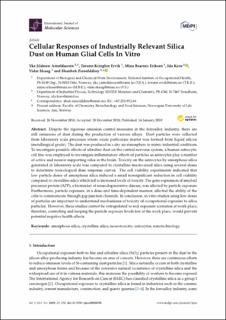| dc.contributor.author | Arnoldussen, Yke Jildouw | |
| dc.contributor.author | Ervik, Torunn Kringlen | |
| dc.contributor.author | Eriksen, Mina Baarnes | |
| dc.contributor.author | Kero, Ida | |
| dc.contributor.author | Skaug, Vidar | |
| dc.contributor.author | Zienolddiny, Shanbeh | |
| dc.date.accessioned | 2020-12-23T11:09:19Z | |
| dc.date.available | 2020-12-23T11:09:19Z | |
| dc.date.created | 2019-01-21T09:04:11Z | |
| dc.date.issued | 2019 | |
| dc.identifier.issn | 1422-0067 | |
| dc.identifier.uri | https://hdl.handle.net/11250/2720925 | |
| dc.description.abstract | Despite the rigorous emission control measures in the ferroalloy industry, there are still emissions of dust during the production of various alloys. Dust particles were collected from laboratory scale processes where oxide particulate matter was formed from liquid silicon (metallurgical grade). The dust was produced in a dry air atmosphere to mimic industrial conditions. To investigate possible effects of ultrafine dust on the central nervous system, a human astrocytic cell line was employed to investigate inflammatory effects of particles as astrocytes play a number of active and neuron supporting roles in the brain. Toxicity on the astrocytes by amorphous silica generated in laboratory scale was compared to crystalline macro-sized silica using several doses to determine toxicological dose response curves. The cell viability experiments indicated that low particle doses of amorphous silica induced a small nonsignificant reduction in cell viability compared to crystalline silica which led to increased levels of toxicity. The gene expression of amyloid precursor protein (APP), a biomarker of neurodegenerative disease, was affected by particle exposure. Furthermore, particle exposure, in a dose-and time-dependent manner, affected the ability of the cells to communicate through gap junction channels. In conclusion, in vitro studies using low doses of particles are important to understand mechanisms of toxicity of occupational exposure to silica particles. However, these studies cannot be extrapolated to real exposure scenarios at work place, therefore, controlling and keeping the particle exposure levels low at the work place, would prevent potential negative health effects. | en_US |
| dc.language.iso | eng | en_US |
| dc.publisher | MDPI | en_US |
| dc.rights | Navngivelse 4.0 Internasjonal | * |
| dc.rights.uri | http://creativecommons.org/licenses/by/4.0/deed.no | * |
| dc.subject | nanotechnology | en_US |
| dc.subject | astrocytes | en_US |
| dc.subject | neurotoxicity | en_US |
| dc.subject | crystalline silica | en_US |
| dc.subject | amorphous silica | en_US |
| dc.title | Cellular Responses of Industrially Relevant Silica Dust on Human Glial Cells In Vitro | en_US |
| dc.type | Peer reviewed | en_US |
| dc.type | Journal article | en_US |
| dc.description.version | publishedVersion | en_US |
| dc.rights.holder | © 2019 by the authors. Licensee MDPI, Basel, Switzerland. This article is an open access article distributed under the terms and conditions of the Creative Commons Attribution (CC BY) license (http://creativecommons.org/licenses/by/4.0/). | en_US |
| dc.source.pagenumber | 14 | en_US |
| dc.source.volume | 20 | en_US |
| dc.source.journal | International Journal of Molecular Sciences | en_US |
| dc.source.issue | 2 | en_US |
| dc.identifier.doi | 10.3390/ijms20020358 | |
| dc.identifier.cristin | 1661873 | |
| dc.source.articlenumber | 358 | en_US |
| cristin.unitcode | 7401,80,63,0 | |
| cristin.unitname | Metallproduksjon og prosessering | |
| cristin.ispublished | true | |
| cristin.fulltext | original | |
| cristin.qualitycode | 1 | |

